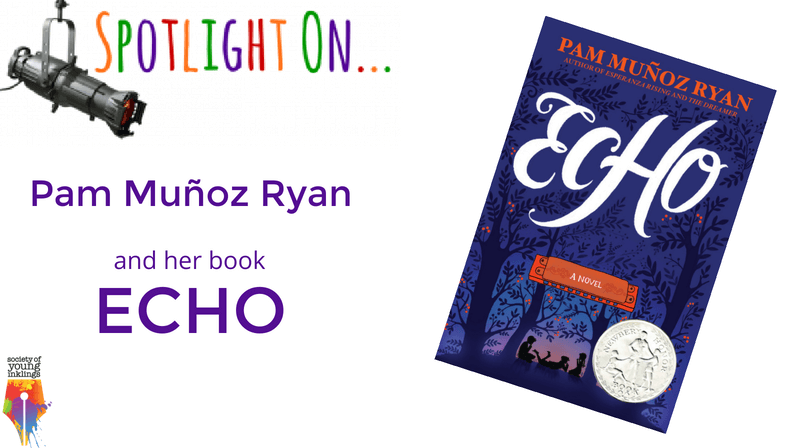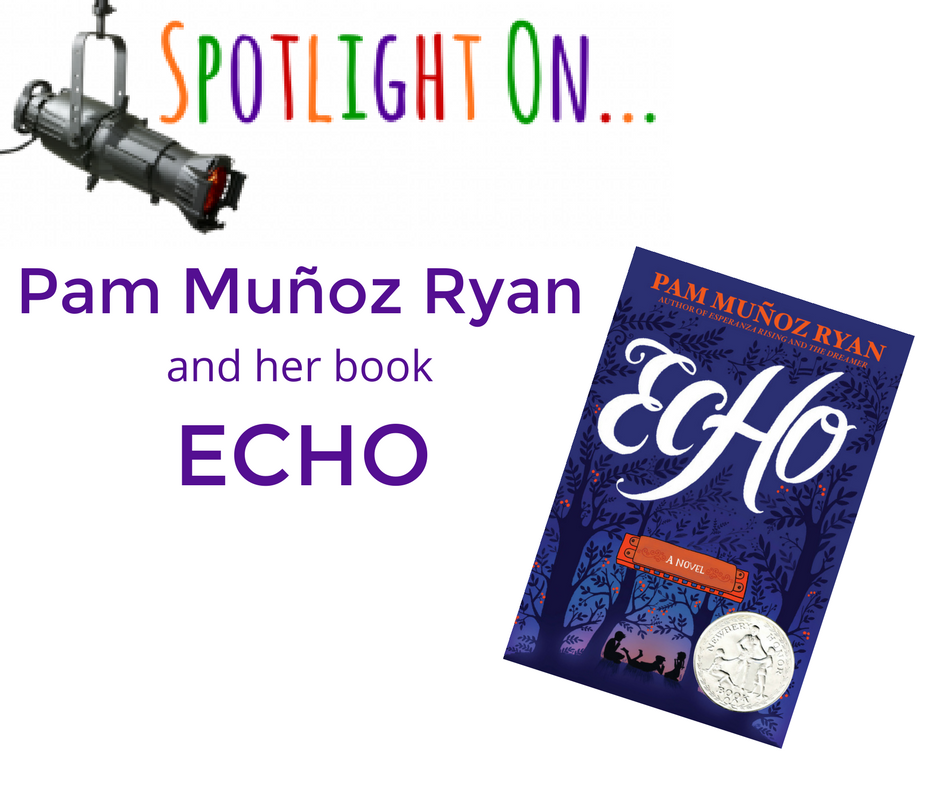
Writing Challenge
A young hero, a violin, and a quilt. How might these objects interact or connect? Create a story with a beginning, middle, and end that incorporates all three things.
Submit your responses by emailing submit@younginklings.org and you might be published on our website! There is no date limit on submissions, so even if you’re reading this after October, we’d still love to hear from you.
ECHO was awarded a 2016 Newbery Honor. Congrats, Pam!
An Interview with author Pam Muñoz Ryan
Did you write when you were young?
Not exactly. As a schoolgirl, I never kept a journal, made a book in class, or had an author visit my school. I never knew that an author was something I could be someday.
It never occurred to me to write a story on paper, but I pretended many, right in my own backyard. I was a benevolent queen, an explorer, or a doctor saving people from precarious deaths. I didn’t know it at the time, but all that dramatic play was a great foundation for writing.
I was also an obsessive reader. The summer before fifth grade, my family moved across town. I was the new kid in a school where most students had been together since kindergarten. I didn’t fit in. I spent much of my free time riding my bike to the East Bakersfield Library to borrow books. It was through books that I escaped and coped with the changes in my life.
There’s no easy way to describe how ideas show up. Do you have a process for seeking out ideas, or do they simply arrive?
You’re right. There is no easy answer to that question. When people ask how a writer gets ideas, what they’re really asking is, “How does your brain work?”
Ideas come in many forms. Sometimes one book leads to another. Sometimes a historical character chooses me, instead of the other way around. Sometimes I read something that triggers more research which leads me down a path. Sometimes a publisher solicits a type of book. For instance when my editor asked me if I’d ever considered writing a horse story, which led to PAINT THE WIND. Sometimes a personal experience or family story will lead to a book. Sometimes a number of ideas converge, becoming a confluence of rivers, and ultimately a story. No easy answer . . .
How did you develop the idea for Echo?
While I was researching what I thought would be my next novel about a little known discrimination case in California in 1931, I came across a photo of a classroom of students sitting on the steps of a school, each holding a harmonica.
When I asked about the picture, the docent, who had attended that very school said, “That was our elementary school harmonica band. Almost every school had one in the 20s and 30s during the big harmonica band movement.”
There was a harmonica band movement?
My curiosity leaped. I went home and began to research. Not only was there a harmonica band movement in the United States, but also Alfred Hoxie’s then-famous Philadelphia Harmonica Band of Wizards, the 60 member band of boys who played in Charles Lindbergh’s parade, and for three presidents. And the band used, primarily, one harmonica—the same model of harmonica in the picture of the children on the steps of the country school—the Hohner Marine Band.
At Society of Young Inklings, we talk about how important it is to follow your curiosity. Your questions clearly led to intriguing details. From there, how did the characters emerge?
I began to wonder about the children in that country school, and in Hoxie’s band. Two fictional characters and their stories began to take shape. Mike, an orphan boy in Philadelphia who wanted to be in Hoxie’s band, which by the way, WAS full of orphans. And Ivy Maria, a girl in a country school harmonica band. I began to wonder, too, if by some odd fate, my characters, at different points in time, had played the same harmonica? And if it that was true, could someone have owned it before them?
I found the answer when I traveled to the Hohner Harmonica company in Trossingen, Germany, to tour the campus and museum of the largest and one of the oldest harmonica factories in the world. There, I learned about the young apprentices who worked in the factory before WWII. Another character’s story, Friedrich’s, began to unfold.
How did you decide to frame the story with a fairy tale and magic?
Since my characters would live through some of the most challenging times in history—Hitler’s Germany, the Great Depression, and segregation—I began to wonder how music might contribute in some way to their ability to carry on through fear and darkness. I began to imagine the harmonica’s back story, and the magic it might carry. That is how Friedrich’s and Mike’s and Ivy’s stories became framed in an original fairy tale and entwined in a witch’s curse and a midwife’s prophecy.
Do you have a favorite place to write?
I write in my office, which is also an extra bedroom in my house. When I look out my window, I see our two apricot trees and our garden, and a small bit of the Pacific Ocean.
What motivates you to keep writing?
That’s simple. I want the reader to turn the page.
A special thanks to Pam Muñoz Ryan!

Pam Muñoz Ryan is an American author. She is half Mexican with Basque, Italian, and Oklahoman cultural influences. She has written over forty books for young people—picture books, early readers, and middle grade and young adult novels. She the author recipient of the NEA’s Human and Civil Rights Award, the Virginia Hamilton Literary Award, and the Ludington Award for body of work. Her novel, Esperanza Rising, was commissioned as a play by the Minneapolis Children’s Theatre and has been performed in many venues around the U.S. including The Goodman in Chicago, and the Majestic Cutler Theater, in Boston. You can visit her website at www.pammunozryan.com.
Click here to buy and learn more about Echo and hear a special reading from the book.



